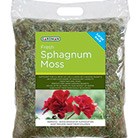New products at Crocus
by Sarah - September 5th, 2010.Filed under: Crocus, New Products.
New items at Crocus
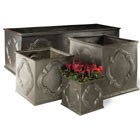
hampton-pot £174.99
Dimensions -Size 1 – 38cm Width x 38cm Depth x 38cm HeightSize 2 – 58cm Width x 58cm Depth x 58cm HeightSize 3 – 78cm Width x 78cm Depth x 75cm HeightSize 4 (trough) – 91cm Width x 33cm Depth x 39cm HeightSize 5 – 142cm Width x 72cm Depth x 72cm Height
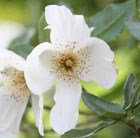
Brush Bush £14.99
Position: full sunSoil: fertile, well-drained soilRate of growth: average Flowering period: August to September Flower colour: whiteHardiness: fully hardy (borderline)Large, scented, bowl-shaped white flowers open in late summer on this coloumnar tree, forming a beautiful contrast to the dark green, leathery foliage. This evergreen seciman looks good throughout to year, but is particularly lovely when in flower. Plant it so its roots get some shade, but the crown will need full sun and shelter from cold, drying winds.Garden care: In mid- or late spring lightly cut back any shoots that spoil the symmetry of the plant. After pruning apply a generous 5-7 cm (2-3in) mulch of well-rotted garden compost or manure around the base of the plant.
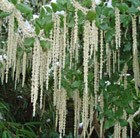
silk-tassel bush £12.99
Position: full sun or partial shadeSoil: moderately-fertile, well-drained soilRate of growth: averageFlowering period: December to FebruaryHardiness: frost hardy (needs winter protection in cold areas)Long, silvery catkins up to 20cm long, shine out among glossy, wavy-edged, dark green leaves throughout winter. The silken tassels of this upright, evergreen shrub make a stunning feature in the winter garden. Try it towards the back of a sunny, shrub border, against a wall or as a windbreak in coastal areas. When it has finished its display, the dark foliage makes a lovely foil for summer-flowering shrubs.Garden care: Cut back dead or straggly branches in April or May.
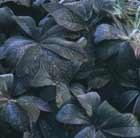
rodgersia £9.99
Position: full sun or partial shadeSoil: humus-rich, moist soilRate of growth: slow-to-establish Flowering period: July and August Flower colour: pinkOther features: attractive pink-tinted seed-headsHardiness: fully hardySpikes of star-shaped, pink flowers on tall stems in mid- and late-summer above deeply divided, copper-tinted, dark green leaves. This bold foliage plant is perfect for the moist, but not waterlogged, margins of a pond or stream. Resist the urge to remove the faded flower-spikes since both the seed-heads and foliage look wonderful frosted in the winter garden.Garden care: Add lots of well-rotted leaf mould when planting. Protect the young foliage against slug damage using beer traps or environmentally friendly slug pellets. Lift and divide congested colonies in early spring.
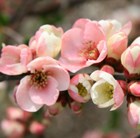
flowering quince £9.99
Position: full sun or partial shadeSoil: moderately fertile, well-drained soilRate of growth: fast-growingFlowering period: March to MayHardiness: fully hardyOrnamental quinces bring a welcome flush of colour to the garden in spring, when their bare twigs are smothered in flowers before the glossy, dark green leaves appear. ‘Moerloosei’ is later flowering than other varieties and has cup-shaped, white flowers flushed pink from March to May, followed by aromatic, greenish-yellow fruit. This vigorous, deciduous quince makes an attractive informal hedge fora sunny or partly shady site with moderately fertile, well-drainedsoil, and looks stunning trained against a wall. The fruit can be eaten when cooked.Garden care: After flowering, prune side-shoots to fiveor six leaves and remove crossing stems. Once established, take out excess growth in late spring or summer and cut back all side-shoots to two or three leaves.
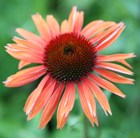
coneflower £8.99
Position: full sunSoil: most soils, except very dry or boggyRate of growth: averageFlowering period: June to AugustHardiness: fully hardyBrilliant orange, daisy like flowers with reflexed petals that flare out from prominent, reddish-brown centres appear from June to August. The flowers are held on erect stems with broad, basal leaves. This is a tough, vigorous (though not invasive) plant that does not need staking and also makes an excellent cut flower. If deadheaded regularly, it will flower profusely for up to three months and it copes well with adverse weather conditions, except drought. Try it dotted through a sunny, mixed border, in bold drifts among ornamental grasses or as part of a ‘hot’ colour scheme. It is attractive to bees and butterflies, and birds will flock to the seedheads.Garden care: Deadhead regularly to prolong flowering. Lift and divide congested colonies in autumn or spring. In autumn cut back all dead flower stems to the ground. Coneflowers benefit from a spring or autumn mulch with well-rotted compost.
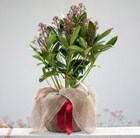
Japanese skimmia (male) £8.99
Position: partial to full shadeSoil: moderately fertile, moist but well-drained soilRate of growth: averageFlowering period: April to MayFlower colour: pinkOther features: male plantHardiness: fully hardyA compact male shrub with red-margined, deep green leaves. Dark red flower buds are produced in autumn and these last all through the winter until the flowers open in spring. A great shrub for growing in a pot or for filling in gaps in the garden border.Garden care: Lightly trim after flowering, if necessary. To improve the moisture retention qualities of the soil add plenty of well-rotted compost when planting.
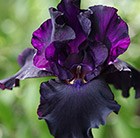
bearded iris £7.99
Position: full sunSoil: well-drained, neutral to slightly alkaline soilRate of growth: averageFlowering period: April to MayHardiness: fully hardyA stunning, bearded iris with dusky, purple-black flowers from April to May and grey-green, sword-like leaves. It looks fabulous planted in drifts in a well-drained, sunny border, as a complement to other blue and purple flowers, or to provide a dramatic accent among paler flowers. Plant towards the middle of the border to fully appreciate the colour.Garden care: Bearded irises prefer full sun and neutral-alkaline soil but if you have acidic or peaty soils you can top dress with lime before planting for good results. Plant shallowly with the upper part of the rhizome sitting on the surface of the soil, incorporating a low nitrogen fertiliser in the planting hole. After planting remove the upper-most third of the leaves to protect against wind-rock. In exposed areas stake with bamboo canes in early spring. Divide and replant about every three years.
common Solomon’s seal £7.99
angelica £7.49
cranesbill £6.99
kirengeshoma £6.99
purple moor-grass £6.99
loosestrife £6.49
Common sage £5.99
granny’s bonnet £5.99
bellflower £5.99
Autumn daffodil £3.99
grape hyacinth £3.99
crocus £3.49







